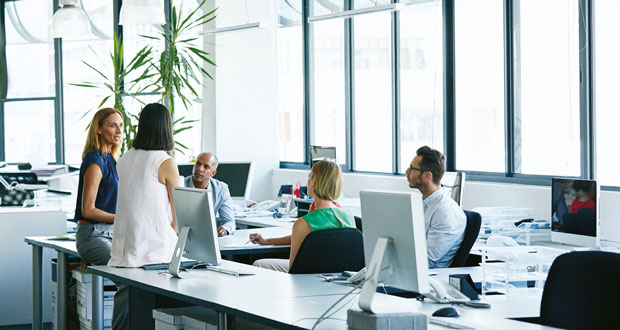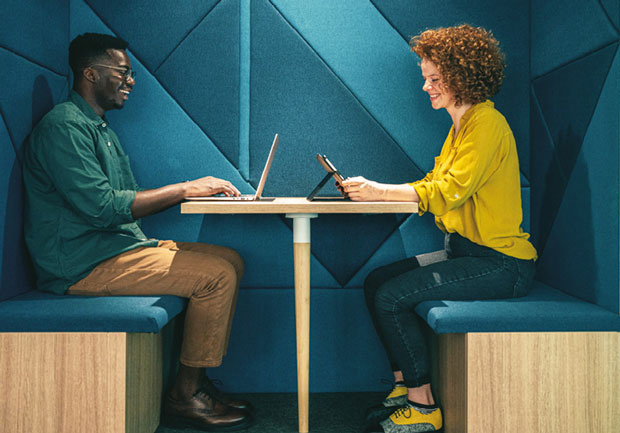REPURPOSED WORKPLACE
The disruption caused by the pandemic has resulted in a massive rethink in the design and layout of the office. According to Katsikakis while around 60 per cent of space in an office was previously devoted to individual desks, it is now predicted to be reduced to about 30 per cent for individual workspaces, supplemented by focus rooms, booths and the introduction of other types of quiet areas such as office libraries.
Meanwhile, she explains: “Collaborative space is going to increase from around 30 per cent to about 50 per cent and that will include more virtual tech integration so that you can really embrace the people who are not there, offering experiences that are much more effective.
“Social, wellbeing and amenity space that would typically have been about five per cent pre-pandemic we expect to go up to about 20 per cent. If you think about the office as a place to connect, to learn and socialise with others, being able to create those intentional opportunities, to make those collisions happen will be really interesting.
“It changes the whole nature of FM if we’re moving from wrenches to smiles. It’s all about curation and a hospitality mindset, by creating and inspiring destinations for people to want to come in and be part of the office.”
There has and will be some debate on whether these changes will result in cuts in corporate real estate and Katsikakis believes clients tend to take one of two approaches: “Either using the same amount of space but with a different layout and design or reducing the core space and leveraging an ‘ecospace’ of locations which will be home, third spaces and the office, so less space but better designed and more curated, alongside touchdown and home.”
One of the discussion points of the BCO debate will be how to meet the expectations of employees which have changed significantly over the past two years and as the challenges of attracting and engaging talent have increased. According to Katsikakis, along with design the allocation of amenities is hugely important, from the provision of great coffee via a barista service to elements like a local pop up restaurant with ethnic food choices, cultural connections and activities you can’t do at home, all of which should be high quality and unique, not just a limp salad bar in the corner.
ESG AIMS
Achieving Environmental, Social and Governance (ESG) is another key theme of the BCO conference discussions. As Knight Frank predicts, “those who create offices that are more customer-centric, reduce environmental impact and proactively utilise technology and data will win in the brave new world of office”.
“How we begin to create an aligned point of view around ESG is very important,” says Katsikakis as it is going to be a critical area of impact both for occupiers and landlords. How those landlords that can support ESG targets that their occupiers are already aiming for to attract occupiers to their buildings and vice versa is going to be a really impactful area for the conference.
“A lot of strategies focus on what can be done with a building to support carbon reduction but we need to put the humanity element into ESG and take a community engagement perspective, from growing your own food on campus, sponsoring local restaurants and organising charity days. All of these aspects we will see have much more emphasis in the built environment as we look to the future.”
She also predicts more investment on end of route facilities. Occupants are no longer happy to cycle to work and just get offered a parking space. They want to have showers, laundry and other really good facilities to enable them to arrive and get changed for work. They also want more wellbeing facilities, exercise areas that are really high quality, meditation and prayer areas. This is where the introduction of technology using real time data to manage the building, manage the experience and the energy, will come into play.
“What I’m finding really interesting is the integration of building apps, booking systems and sensors that can help manage how often you clean in the building, how much food you order and what type of food you provide to support users’ demands. Workplace managers and occupants are excited to use that tech because they recognise the sustainability component. If the building knows that I like salads and it orders more of that there is less food wastage and it results in a more responsive environment.
“I think this is a very exciting area for the future as it means over the few years we’ll have real time analytics and data to really forecast capacity, services, and adapt them accordingly.”
WORKING TOGETHER
One of the aims of the conference is to bring all those involved with the future attributes of the office together to debate the opportunities for the sector to re-evaluate and reset. This says Katsikakis means FM and CRE collaborating more than ever before to engage the C-suite in making positive changes for the future.
“CRE and FM have to work together in a completely seamless and integrated way because the value is not saving the cost of real estate or the cost of FM delivery. The value is in creating memorable and impactful experiences. FM is at the forefront of that, so that FM is really where you operationalise the entire corporate real estate strategy, and make it work.
“The reason why that becomes critical for the C-suite is that the objective of every single organisation at the minute is around ‘how do I attract and retain talent? How do I inspire people to come to the office to make those connections?’ Our data shows a direct correlation between the level of experience within the office to the level of engagement with the company and that goes across the board in terms of demographics.
“For the first time ever, we’re seeing the correlation between experience and engagement and engagement is the number one metric that HR use to look at how they can retain talent. With the FM experience at the sharp end of that interface of the employee with the workplace, it becomes the critical driver for business performance.”







